On the championing by Damian Michaels of the "forgeries" (refer qualification below) of Lukasz Banach:
Defining FORGERY the qualification:
According to the online Nationmaster, a forgery is a work knowingly passed off as a work by another.
However, the term forgery also applies to works created by someone which appear to be like those created by another even if they are not passed off as the work of another:
The Horton Pollock TV documentary definition:
New York Times online article on the Horton Pollock: http://www.nytimes.com/2006/11/09/arts/design/09poll.html
Screened as "Who The #$&% Is Jackson Pollock?" on ABC tv Australia 3:00 PM, Sunday, 16/11/2008 (url: http://www.abc.net.au/tv/guide/abc2/200811/programs/ZY9536A001D9112008T203000.htm)
One of the interviewees was a convicted British forger. He now legally sells forgeries in the manner of the works of artists such as Picasso. The art of any artist is © copyright of the artist and remains © of the artist's estate for a period of 75 years after the artist's death (which is dependant on each individual country's legal definitions). The British forger who legally forges "Picasso" amongst other artists, would be in breech of © if he were to copy outright a proven Picasso. The nature of his forgery is that his paintings can be mistaken for a painting done by Picasso. The legality of such forgery is predicated on the works being signed in the forger's own name and not in the name of the artist's work being so forged. These works are therefore legal fakes because they do not make any claim to being the art of the artist whose work is being emulated/forged, even though they look just like the work that artist produced; and they do not breech copyright because they are not outright copies of known works by that artist.
|

|
The Orange Regional Gallery (Art Museum), in the Australian state of New South Wales hosted an exhibition in early 2001 with the title "Fantastic Art." It was curated by Damian Michaels. In the catalogue which accompanied the exhibition, Alan Sisley, director of the Gallery paid tribute to Damain Michaels for his collection: "I am grateful to Damian Michaels not only for his unerring professional exhibition development, but also for drawing so many of these fine artists to my attention." (p.2). The exhibition at Orange was of paintings collected by Damian Michaels as acknowledged on the final page of the catalogue (p.20): "All works in this exhibition are from The Collection Art Visionary."
The means by which a collection might be acquired
Though I cannot speak for all other works in the exhibition, the means by which Michaels might have come to "acquire" these works is of interest. Michaels emailed me to "invite" me to contribute one of my works to be included in this show. The "invitation" took the form of a request that I donate a painting to him, so that it would become part of his "Collection Art Visionary", for it to therefore qualify for the exhibition. Put simply, this was a request for a payment to be made in the form of a painting. Damian Michaels had already "acquired" a collection of works during the production of the 3 issues - with the promise of many more issues to follow - of his magazine ArtVisionary.
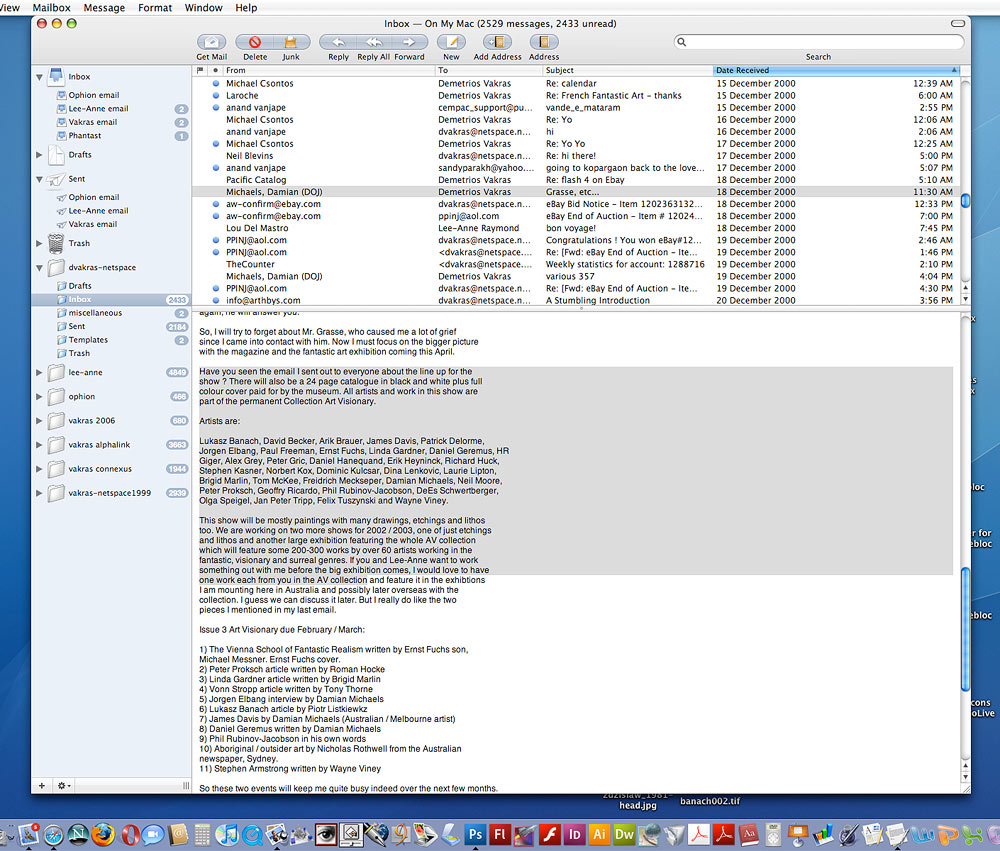
Above: screenshot of Michaels email
From: Damian.Michaels@justice.vic.gov.au
Subject: Grasse, etc...
Date: 18 December 2000 11:30:55 AM
To: dvakras@netspace.net.au
"There will also be a 24 page catalogue in black and white plus full
colour cover paid for by the museum. All artists and work in this show are
part of the permanent Collection Art Visionary. ... I would love to have
one work each from you in the AV collection."
l declined Michaels' "invitation", primarily on 2 grounds, my objection to making payment for my inclusion in an exhibition in which the curator would keep the works selected for exhibition, and that this exhibition would include the forgeries of the works of Beksinski by Lukasz Banach.
Regarding Sisley's claim to Michaels' "professionalism": The Orange Regional Gallery catalogue lists sponsors on p. 24. Art Museums should list their benefactors. "Benefactors" includes bequests made by artists or patrons. Artists who "donated" their works to Michaels are not listed.
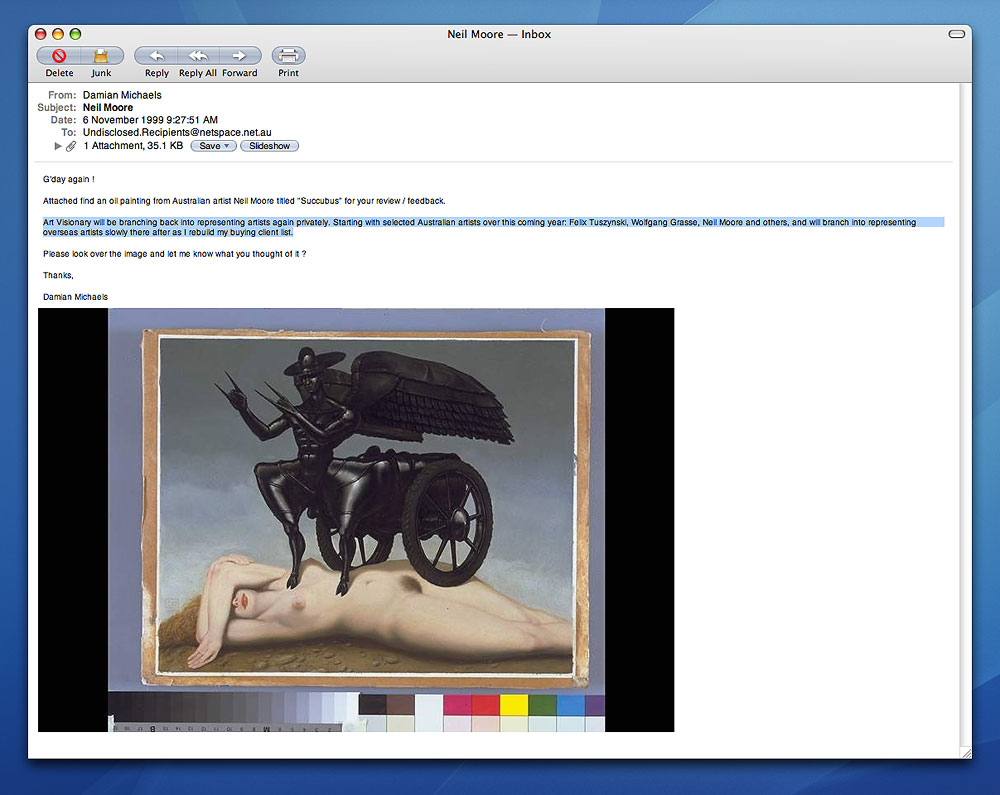
| Above: an earlier email from Damian Michaels dated 6/11/1999.
It reads: "Art Visionary will be branching back into representing artists again privately. Starting with selected Australian artists over this coming year: Felix Tuszynski, Wolfgang Grasse, Neil Moore and others, and will branch into representing overseas artists slowly there after as I rebuild my buying client list."
I first met Michaels in 1997 after he had procured my telephone number from Roar Studios, the Melbourne art gallery I exhibited with. He represented himself to me as an agent with an interest in selling my works.
After the launch of the first issue of his magazine, ArtVisonary, he claimed that he would be returning to his role as an artists' agent. Indeed, in this email he admits that his magazine is intended as a catalogue of artists he either represents, or desires to represent.
|
Another exhibition was organised by the Orange Regional Gallery to follow the first. This second exhibition was basically the original show re–branded with the addition of "visionary art". It included a few additional works which were absent in the first. This exhibition and accompanying catalogue were titled "Fantastic and Visionary Art: An Orange Regional Gallery Touring Exhibition." In 2004 the travelling exhibition opened in the regional city of Ballarat in the state of Victoria. Alan Sisley in the catalogue which accompanied this show wrote: "Damian Michaels is indeed an artist of Vision, whose collection, magazine, and eventual museum will surely take their place among the significant art events in this country." (p. 5)
Michaels has championed a number of artists. Included in their number was the irrelevant Lukasz Banach. Michaels knew that Banach did not produce original works, but considered this to be irrelevant. In an email to him I pointed out that Banach is not a bona fide artist with the following comments:
"Banach's drawings are almost exact copies of Beksinski drawings & paintings. Almost because he simply makes only one or two alterations, usually taken from another Beksinski image! Beksinski's image on page 29 of the Morpheus book is nearly identically reproduced by Banach on his website except that the eyes have been replaced by flowing curtains. Flipping though the Morpheus publication on Beksinski whilst at the same time looking at Banach's site on-line, image after image can be sourced back to a specific Beksinski drawing." (URL for the Banach website at that time: http://www.geocities.com/banach_us ) The Banach site has since disappeared, and Banach subsequently destroyed most of his Beksinski–derived works after Beksinski was murdered, so the images I referred to are no longer available:
|
" Banach destroyed most of his paintings in the summer of 2001."
http://www.belvederegallery.com/artist_more.php?id=4
|
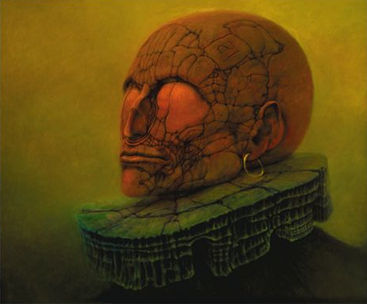 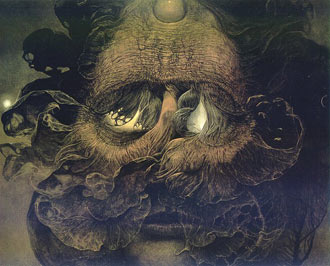
Above: Left: the beforementined image that appears on p. 29 of the Morpheus book on Beksinski. Right the Beksinski image with "curtains" flowing from the eyes. Banach replaced the eyes of the image on the left with the eyes of the image on the right. (Beksinski images which appear in the Morpheus book can be found on the following on–line catalogue of Beksinski works.)
|
Michaels however had no problem with Banach, as his response which follows, shows.
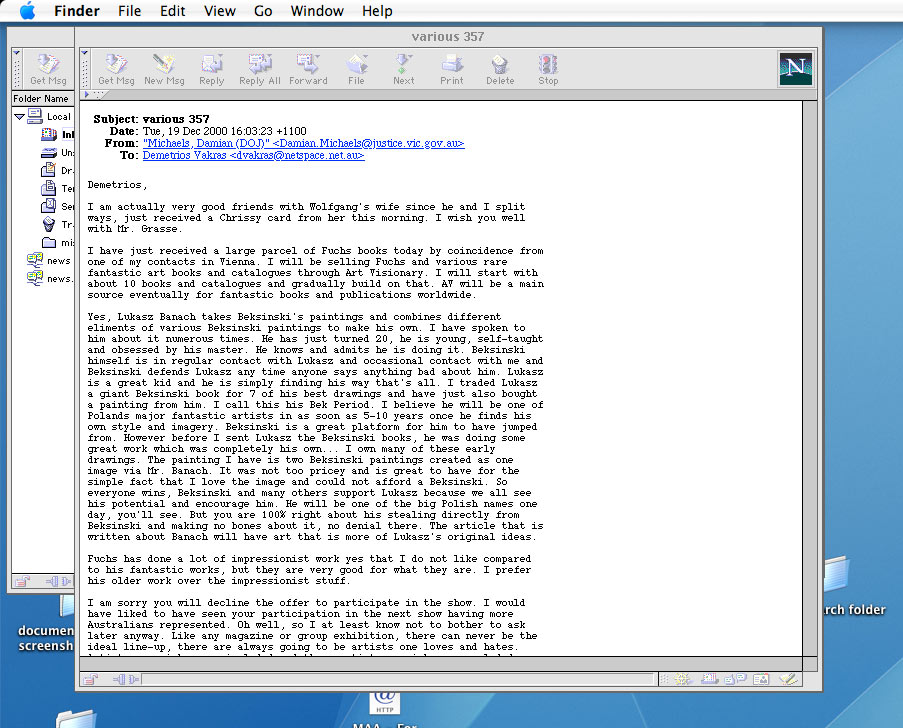
Subject:
"various 357"
Date:
Tue, 19 Dec 2000 16:03:23 +1100
From:
"Michaels, Damian <Damian.Michaels@justice.vic.gov.au>
To:
Demetrios Vakras <dvakras@netspace.net.au>
"Demetrios,
…Yes, Lukasz Banach takes Beksinski's paintings and combines different
eliments of various Beksinski paintings to make his own. I have spoken to
him about it numerous times. He has just turned 20, he is young, self-taught
and obsessed by his master. He knows and admits he is doing it. Beksinski
himself is in regular contact with Lukasz and occasional contact with me and
Beksinski defends Lukasz any time anyone says anything bad about him. Lukasz
is a great kid and he is simply finding his way that's all. I traded Lukasz
a giant Beksinski book for 7 of his best drawings and have just also bought
a painting from him. I call this his Bek Period. I believe he will be one of
Polands major fantastic artists in as soon as 5-10 years once he finds his
own style and imagery. Beksinski is a great platform for him to have jumped
from. However before I sent Lukasz the Beksinski books, he was doing some
great work which was completely his own... I own many of these early
drawings. The painting I have is two Beksinski paintings created as one
image via Mr. Banach. It was not too pricey and is great to have for the
simple fact that I love the image and could not afford a Beksinski. So
everyone wins, Beksinski and many others support Lukasz because we all see
his potential and encourage him. He will be one of the big Polish names one
day, you'll see. But you are 100% right about his stealing directly from
Beksinski and making no bones about it, no denial there. The article that is
written about Banach will have art that is more of Lukasz's original ideas."
What Michaels' response exposed was an absolute lack of any understanding of why some artists are considered historically important and why others are worthless; for him great art is best demonstrated by a practitioner's ability to mimic the work of an acknowledged master. Sisley considers Michaels to be a "curator" of "vision" even though his actions appear to be more like those of an artist's agent or promoter.
| Damian Michaels is a fan of Christian–religious artists such as Ernst Fuchs. Sisley describes him as an "artist". And he does make some attempt at drawing. His early efforts appear to be his attempts to emulate the style of artists such as Fuchs. However, he lacked the talent to actually pull it off. I once described Michaels' belaboured drawings as: the kind of drawing arrived at by persistence to succeed against the absence of any natural ability to draw. It is this context in which is provided the answer to why Michaels would believe Banach to be a great artist: Banach could fairly closely approximate the style of the artist he chose to be like, whereas Michaels never quite could. Michaels' belaboured attempts to draw were/are exhibited by Sisley as "outsider art". Outsider Art should be considered as works produced by people who though lacking any artistic skill nevertheless persist with sufficient determination to produce works that though generally clumsy and ugly are praiseworthy because of the determination of their creators to create them. |
Beksinski originals
The paintings above are all of Beksinski originals. (This site features the most complete on–line catalogue of Beksinski works.) None of the works are titled. Beksinski's rare comments in which he explains his aversion to using words indicate some form of cognitive retardation:
"Writing your own biography is a sign of even greater vainglory than making declarations like the ones I have written at the request of the makers of this catalogue." quoted from http://www.belvederegallery.com/artist_more.php?id=2
(For Beksinski painting for the purpose of exhibiting, and any consequent accolades for the art produced, is not vainglory; but writing of the intentions behind the works is.) From the same site: "Despite the grim overtones, he claimed some of these paintings were misunderstood, as they were rather optimistic, or even humouristic.", hence the depiction by Beksinski of bloodied genitals is "optimistic."
Below appear some forgeries of Beksinski's images by Banach. They are not exact copies, but can be mistaken as Beksinskis, though Banach lacked the technical skill of his master. Like Beksinski whom he unquestioningly emulated he does not title his works.
Banach forgeries
Michaels conceded that there was an absence of originality in the works produced by Banach, but included him in his magazine nevertheless. He wrote to me "The article that is written about Banach [for ArtVisionary 3] will have art that is more of Lukasz's original ideas." Below are 2 of these "originals" which are no less Beksinski copies than anything else Banach produced.
Banach forgeries
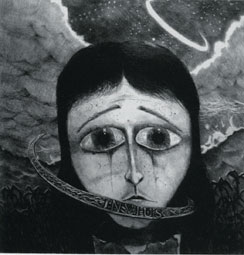
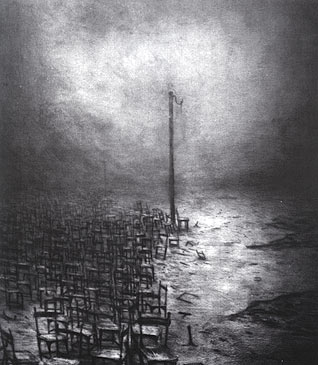
Lukasz's originals?
According to Michaels AV3 was to feature works by Banach which were not derived from Beksinski. The face above derives from faces which appear in Beksinski images such as the one right (detail top right). The chair features in Beksinski images. Banach simply multiplied them.
|
|
|
Worse still was the article in ArtVisionary 3 written by Poitr Listkiewicz:
| "Lukasz Banach. What can you say about a man born with the ability to perfect everything he touches…How can we explain that this man, born just 19 years ago, is able to do things which other people cannot do to such perfection even after years of intensive studying and practising? …Banach perceives beyond the normal range of other people's perception. His inner eye reaches a boundary of worlds…" p.45 |
One wonders about this "inner eye" which though capable of seeing "beyond the normal range of people's perception" could only see as far as Beksinski.
The inclusion of Banach in the magazine and the inclusion of his works in the 2 Orange Regional Gallery exhibitions seriously diminished the works of artists whose works were also exhibited and diminished the reputation of Sisley - one would have expected greater accademic rigour in the selection of works to be exhibited. Michaels' contribution to art of the imagination, aided by figures such as Sisley has been to diminish any and all practitioners of art of the surreal/fantastic, rendering them instead as absurdities worthy only of ridicule.
Michaels' intentions have been guided by an artistic revisionism in which he intends to promote specifically Christian art which he redefines as "visionary". In the forward to the catalogue for the exhibition "Fantastic and Visionary Art: An Orange Regional Gallery Touring Exhibition" Sisley wrote:
| "Visionary Art is a description derived from the great psychiatrist Carl Jung, who believed the Visionary Mode derived from the historical unconscious and pointed to things unknown…Jung said: 'Art is a kind of innate drive that seizes him and makes him its instrument', …the majority of artists in this exhibition would identify with Jung's notion of the artist/shaman…many of the artists in this exhibition are now, or have been in the past, subject to intense visionary experience that they have understood in more or less supernatural and spiritual terms." (p. 1) |
A short note on Jung's "archetypes": In 19th century Germany, Plotinus, his Enneads, and like-minded philosophers were very much in favour. The Germans invented the misleading term "neoplatonism" to describe these philosophers. Both Freud and Jung filched Plotinus' ideas on the soul and its divisions, along with the Platonic basis for Plotinus, that an abstraction, IDEA (usually mistranslated as "form" in English), precedes the actual. This IDEA is the "archetype" or "primary form" ascribed to ideas by Jung. The concern of Plotinus was the soul, ψυχή, psyche, hence "psychology" - logic of the soul. A more complete debunking of Freud and Jung lies outside the scope of this essay.
Amazon links: Plotinus' Enneads "Neoplatonism")
|
With the death of Beksinski the talentless Banach found himself rudderless and has since changed both his direction and name. He now calls himself "Norman Leto". The success he gained in forging Beksinski, and in finding in Michaels someone willing to buy these forgeries has secured him a page in both the Polish–language and English–language Wikipedia.
According to http://www.belvederegallery.com/artist_more.php?id=4 :
"In 1999 [Banach] decided to drop high school and started working on graphics and painting on his own. He is a self-taught artist. For several months Banach worked for a company which specialised in animation and film production. In 2001, Banach participated in a group exhibition in Melbourne which brought him huge popularity in Australia and first offers to purchase his artwork."
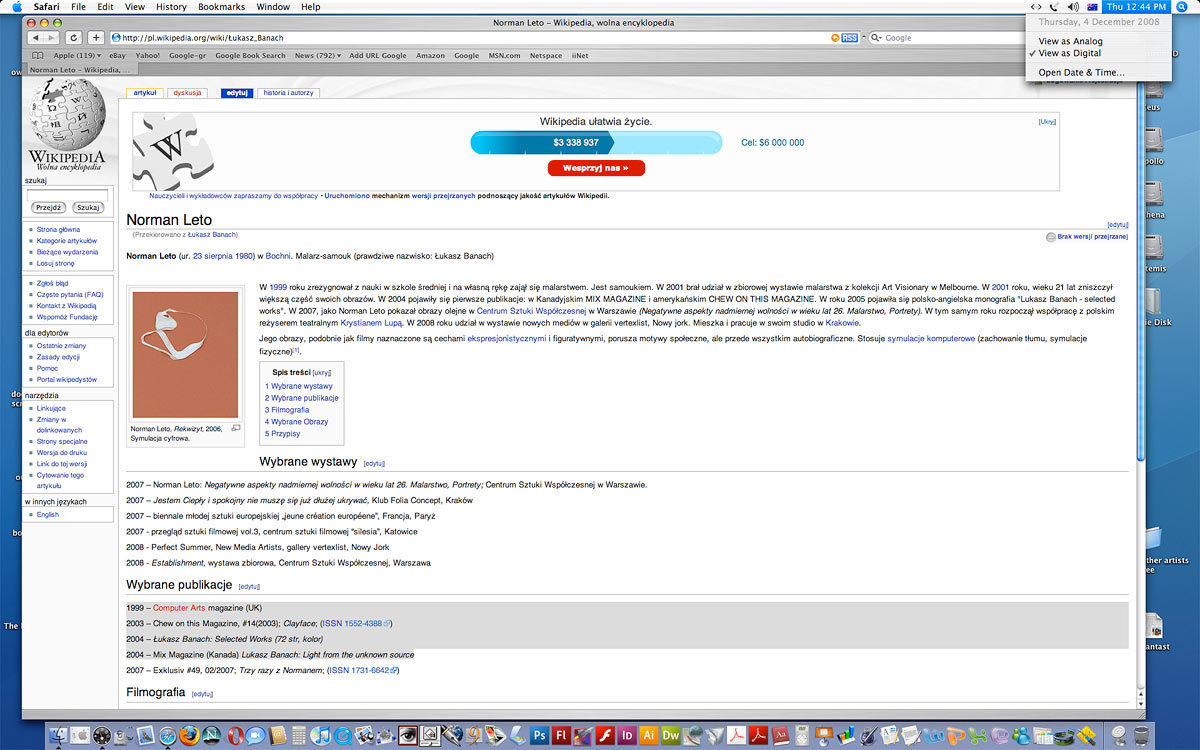
Polish English
Addenda 10/1202008. Banach was not the only artist who was bereft of his own ideas and took the style and motifs of others that was championed by Michaels. He also championed Alex Grey. Below is a photograph of an article from The Courier, newspaper of Ballarat 23/7/2004 showing the Ballarat Gallery director in front of a work by Grey. The article was the review of the Ballarat opening of the "Fantastic and Visionary Art: An Orange Regional Gallery Touring Exhibition." Alex Grey is dealt with on another page.
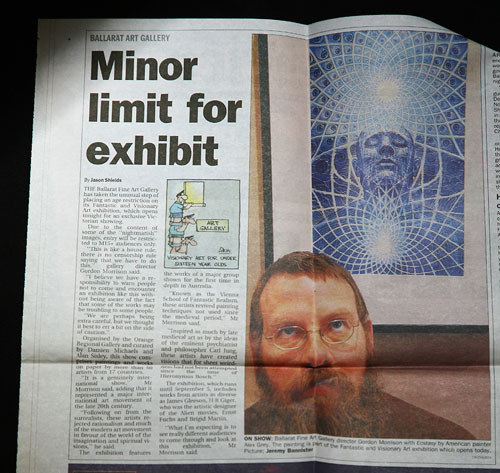
Demetrios Vakras 5/12/2008.
|
graphics and text © demetrios vakras
paintings reproduced here remain the © of the artists (or their estates) and are reproduced here on the principle of fair use.
www.vakras.com
|

